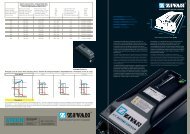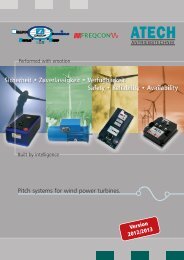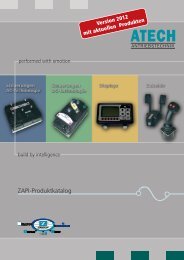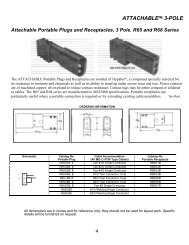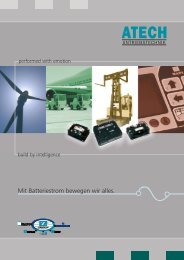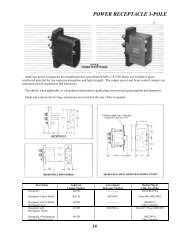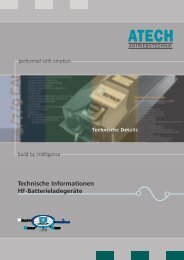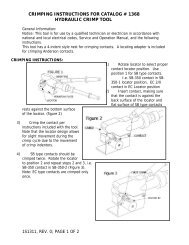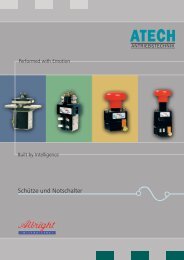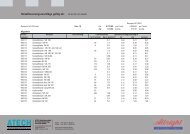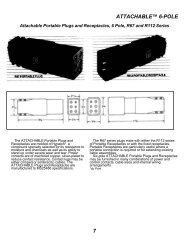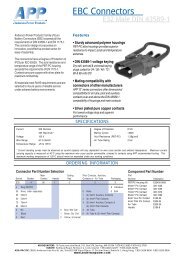Batteriestecker - Atech Antriebstechnik
Batteriestecker - Atech Antriebstechnik
Batteriestecker - Atech Antriebstechnik
You also want an ePaper? Increase the reach of your titles
YUMPU automatically turns print PDFs into web optimized ePapers that Google loves.
| Press and Applicator Tools |<br />
Anderson Power Products ® , in partnership with Application Tooling Solutions, has engineered a line of application tooling for<br />
APP ® ’s reeled contacts. All applicators have been designed to meet or exceed UL requirements. See connector family tooling<br />
charts at the end of each section for the specific press, air feed kit, and applicator recommended for crimping each contact.<br />
• Designed Specifically For APP ® Contacts<br />
Provides crimps that meet or exceed UL requirements<br />
• World-Wide On-Site Service<br />
Provided through ATS’s extensive field service network<br />
• Mini-Style Applicators Can Be Adapted To Most Existing Presses<br />
AMP, K & T presses, Kenco presses, and most other manufacturers<br />
• Contact ATS Directly to Purchase or Lease Tooling<br />
P.O. Box 6780, Harrisburg, PA 17112 USA<br />
T:877-671-2955 F:717-810-2862<br />
www.applicationtooling.com<br />
| Crimping Technical Reference |<br />
Crimping, Soldering, and Assembly Best Practices. Instructions for proper assembly are available for each connector<br />
and should be followed. These best practices are for reference only.<br />
Stripping Wire Insulation<br />
Problems with cable harness and connector systems often begin with improper or accidental cutting of wire strands when stripping<br />
wire insulation. Each strand is important, and all of them must be included in the contact barrel to avoid unnecessary hot spots<br />
during later operation. When removing insulation, position a sharp blade at a right angle and apply a steady controlled pressure<br />
cutting only the cable insulation and not the copper wire strands. Wires should be stripped to the lengths specified in the specific<br />
connector assembly instruction.<br />
Cleaning Copper Wire<br />
Copper oxide, a non-conductive material accumulates on copper wires exposed to oxygen and moisture. Aged and badly<br />
tarnished copper wire needs to be thoroughly cleaned to realize the rated performance of the connector and wire. Heavy<br />
oxidation can be scraped off with a stiff wire brush that penetrates the entire bundle and cleans every strand. For light<br />
surface oxidation a 3M Scotch Bright pad is recommended. The wires are ready for insertion into the contact barrel<br />
when they are burnished to their original bright copper finish. Contact barrels are lined with silver or tin plating to assure<br />
consistently high conductivity which will be reduced if the barrel is crimped around aged or tarnished wire.<br />
Crimping<br />
APP ® connectors are designed to achieve the highest levels of durability, reliability, and performance as shown on the connector<br />
data sheets. Crimp tooling is a critical link between the designed performance of an APP ® connector and the realization of that<br />
performance by our customers.<br />
SECTION 4<br />
Tooling<br />
As part of the connector design and testing process, APP ® recommends a limited number of crimp solutions that have proven to<br />
deliver the intended connector performance in a process that is repeatable. Only these solutions tested by APP ® are listed in the<br />
conditions of acceptability from safety agencies such as UL, CSA, and TUV.<br />
Use of tooling solutions not tested by APP ® can affect not only performance but also safety agency approvals. Problems attributable<br />
to use of tools not recommended by APP ® include:<br />
Electrical and Thermal<br />
• High electrical resistance<br />
• Failure to realize designed current and voltage carrying capability<br />
• Overheating<br />
• Melting of connector housings<br />
Mechanical<br />
• Contacts not able to fit inside connector housings.<br />
• Contacts not seated properly in connector housings causing: shorts, intermittent circuits, abnormally high or low mating and<br />
unmating force, & low retention force of the contact in the housing<br />
- 98 - www.andersonpower.com<br />
All Data Subject To Change Without Notice



